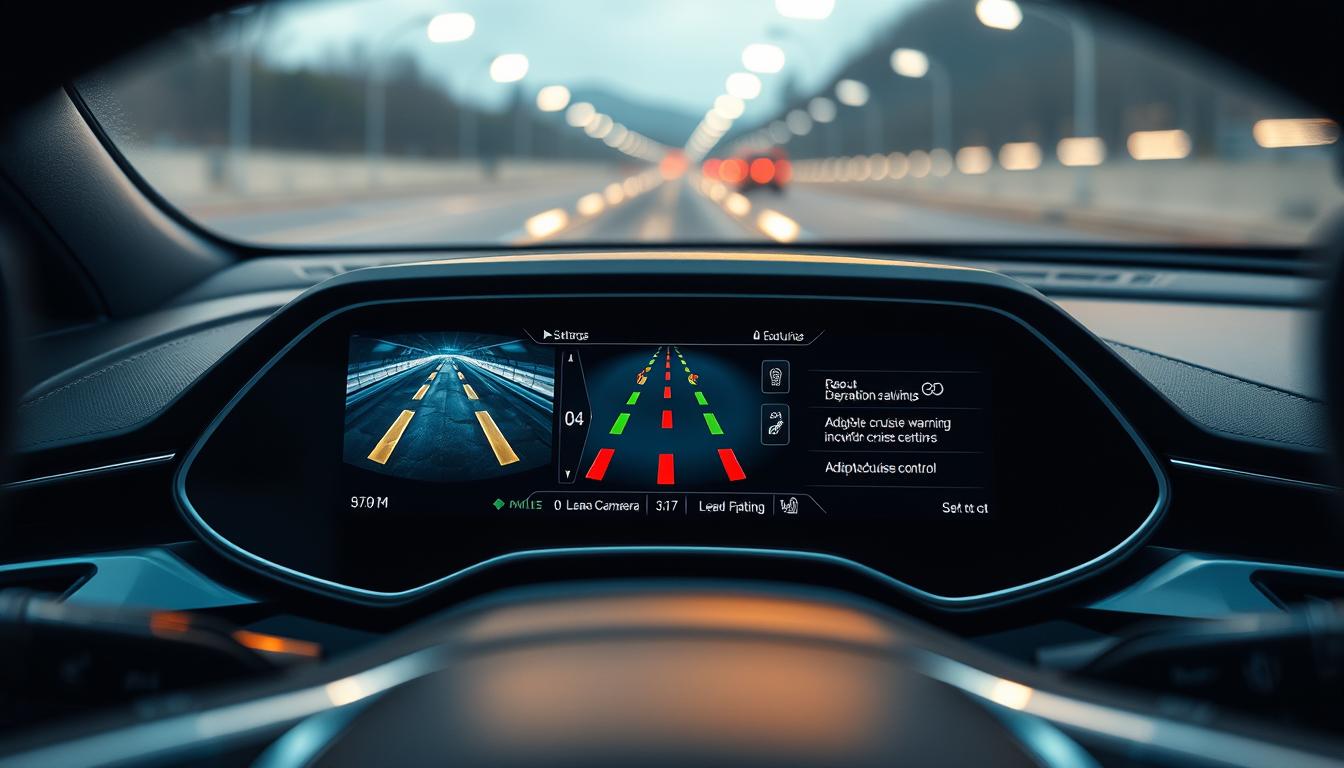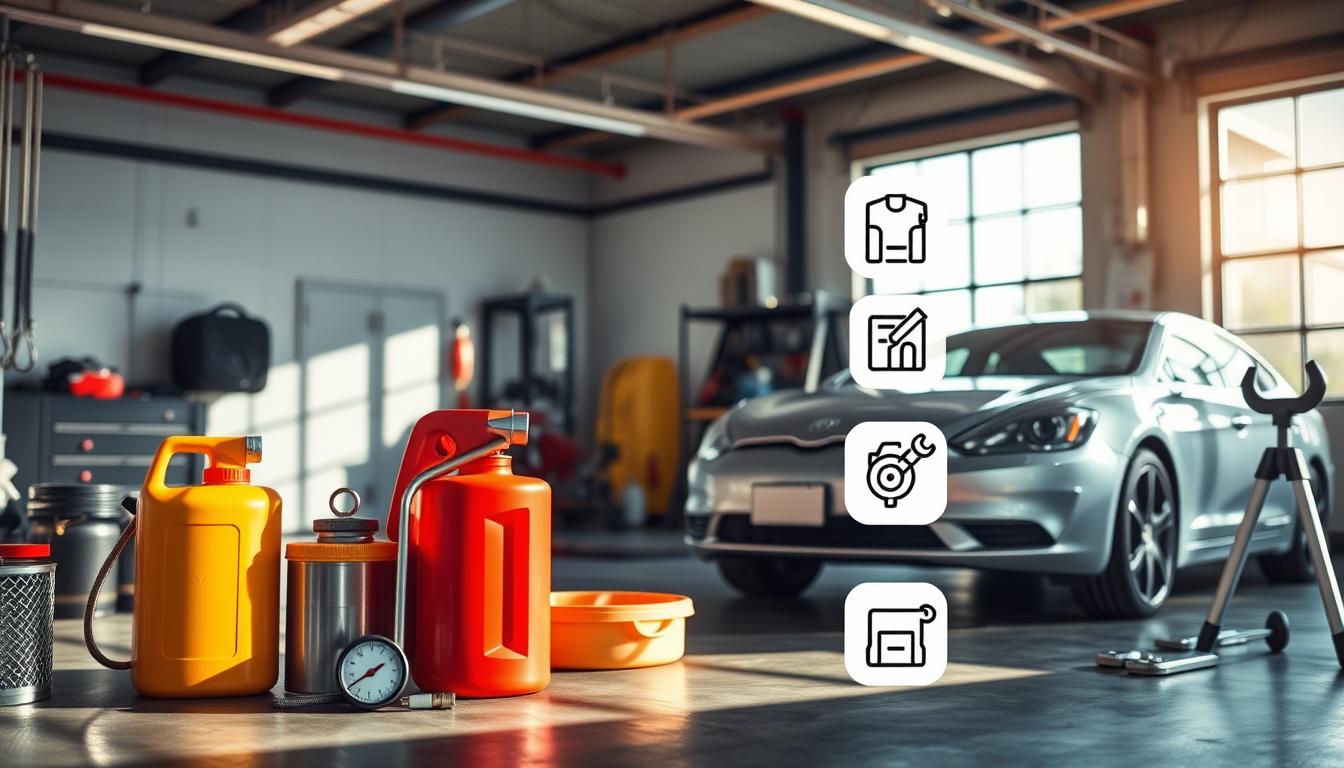We at Car Nest aim to help car lovers stay updated with the latest trends and advice. Knowing the top car safety features is key to keeping everyone safe. Our car reviews cover everything you need to know to choose a safe vehicle.
Exploring car safety means learning about the latest tech. From simple to advanced features, knowing them can save lives.
Introduction to Car Safety
At Car Nest, we’re dedicated to guiding you to make smart choices for your car. Whether you’re buying new or upgrading, knowing the best safety features is vital. With today’s safety tech, you can drive confidently, knowing you’re protected.
Key Takeaways
- Understanding car safety technology is key for safety
- Top safety features include basic and advanced tech
- Vehicle safety innovations keep getting better
- Knowing the top safety features can save lives
- Car Nest offers detailed guides and expert advice on car safety
- Staying informed about car safety empowers car owners
Understanding Basic Car Safety Features
Car safety often brings to mind advanced safety systems and new tech. But, the real foundation is basic car safety features. These include seatbelts, airbags, and anti-lock braking systems (ABS). They work together to keep people safe in accidents. Knowing how they work helps us see why vehicle safety is key and how to pick a safe car.
Some important basic car safety features are:
- Seatbelts: keep people in the car and stop them from being thrown out
- Airbags: soften the blow of a crash to lessen injuries
- Anti-lock braking systems (ABS): stop wheels from locking up to keep control
These features help a car get a good safety rating. Safety ratings come from tough tests. They show how safe a car is. By looking at these ratings and the best car safety features, we can pick a car that’s right for us.
What Makes a Car Safe?
A safe car has both basic and advanced safety systems. These systems help prevent accidents and protect people in crashes. Knowing what makes a car safe helps us choose wisely.
Importance of Safety Ratings
Safety ratings are key when buying a car. They tell us how safe a car is. By looking at safety ratings and the best car safety features, we can find a car that’s safe and meets our needs.
Airbags: Your First Line of Defense
Airbags are key in car safety. They protect drivers and passengers in crashes. Our reviews show how important they are in preventing injuries.
Airbags deploy quickly to cushion the impact of a crash. This is vital in high-speed accidents. They help reduce the force of the impact.
Front Airbags
Front airbags protect the driver and passenger from the steering wheel and dashboard. They are a standard in most cars. They are a critical part of a vehicle’s safety.
Side Airbags
Side airbags protect against side impacts. They deploy from the seat or door. They help prevent injuries to the torso and pelvis. 
Curtain Airbags
Curtain airbags prevent ejection in rollovers or side impacts. They deploy from the roof. They keep occupants inside, reducing injury risk.
In summary, airbags are essential in car safety. Knowing about the different types helps us see their importance. They play a big role in preventing injuries and saving lives.
| Type of Airbag | Deployment Location | Purpose |
|---|---|---|
| Front Airbag | Steering wheel and dashboard | Protect driver and front passenger from frontal collision |
| Side Airbag | Seat or door | Protect occupants from side impacts |
| Curtain Airbag | Roof | Prevent ejection from vehicle in rollover or side impact |
Antilock Braking Systems (ABS) Explained
We think it’s key for drivers to know about car safety tech. The antilock braking system (ABS) is a big step forward. It stops the wheels from locking up when you brake hard.
ABS is super helpful in emergency stops. It lets you keep control of your car, cutting down on skidding and crashes. Let’s dive into why ABS is so good in emergencies.
How ABS Works
ABS kicks in fast when it sees a wheel might lock up. It pumps the brakes quickly to keep the wheels gripping the road. This lets you steer safely.
The system uses sensors and valves to do this. It’s a complex tech that shows how advanced car safety has become.
Benefits of ABS in Emergency Situations
ABS is a game-changer in emergencies. It keeps your car stable and prevents skidding. This means fewer accidents and injuries.
- Improved vehicle control during hard braking
- Reduced risk of skidding and accidents
- Enhanced safety in emergency situations
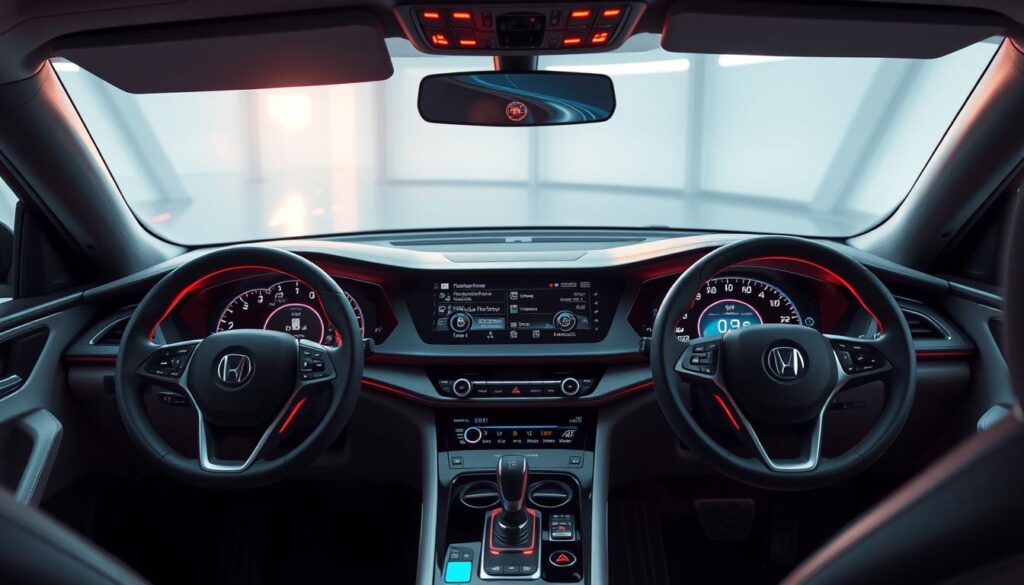
In short, ABS is a must-have for car safety. Knowing how it works and its benefits makes driving safer and more confident.
Electronic Stability Control (ESC)
We’re excited to explore vehicle safety innovations, focusing on advanced systems like Electronic Stability Control (ESC). This feature helps prevent skidding and loss of control. It’s a key part of modern vehicles.
So, how does ESC work? It automatically adjusts engine power and applies the brakes to individual wheels. This helps stabilize the vehicle. It’s very useful on slippery roads or sharp turns.
The Function of ESC
ESC uses sensors and computer algorithms to monitor the vehicle’s speed, steering, and traction. If it detects a loss of stability, it acts fast to prevent a skid or accident. This shows how vehicle safety innovations are making our roads safer.
ESC and Skid Prevention
ESC prevents skids and loss of control, reducing accident risk. This is great for drivers who might struggle in emergency situations. With ESC, drivers feel more confident and secure, knowing their vehicle has the latest safety features.
Some key benefits of ESC include:
- Improved stability and control
- Reduced risk of skidding and accidents
- Enhanced safety features for drivers and passengers
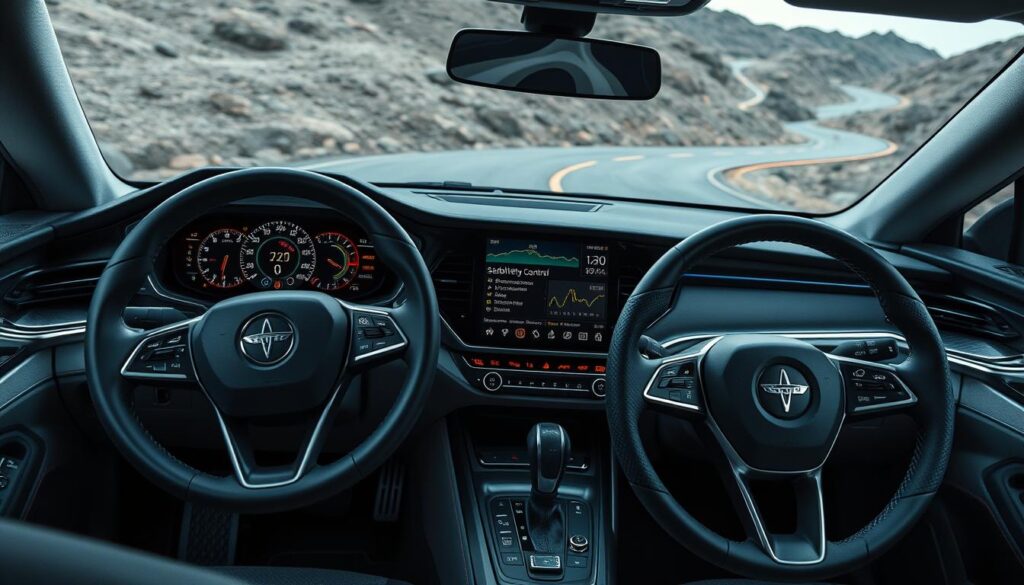
Advanced Driver Assistance Systems (ADAS)
We aim to keep you informed about the latest in car safety tech, focusing on the best safety features. Advanced Driver Assistance Systems (ADAS) are a big step forward. They offer features to boost safety and lower accident risks.
Looking into the top safety features in cars, ADAS stands out as a leader in innovation. It uses advanced tech to help vehicles spot and react to dangers. This gives drivers more protection on the road.
What is ADAS?
ADAS includes many features like lane departure warning, blind spot detection, and forward collision warning. These systems use sensors, cameras, and radar to spot and act on hazards. They are key parts of the best car safety features.
Key Technologies in ADAS
Some main tech in ADAS are:
- Camera systems for detecting lane markings and hazards
- Radar sensors for checking the distance and speed of nearby cars
- Ultrasonic sensors for finding obstacles and helping with parking
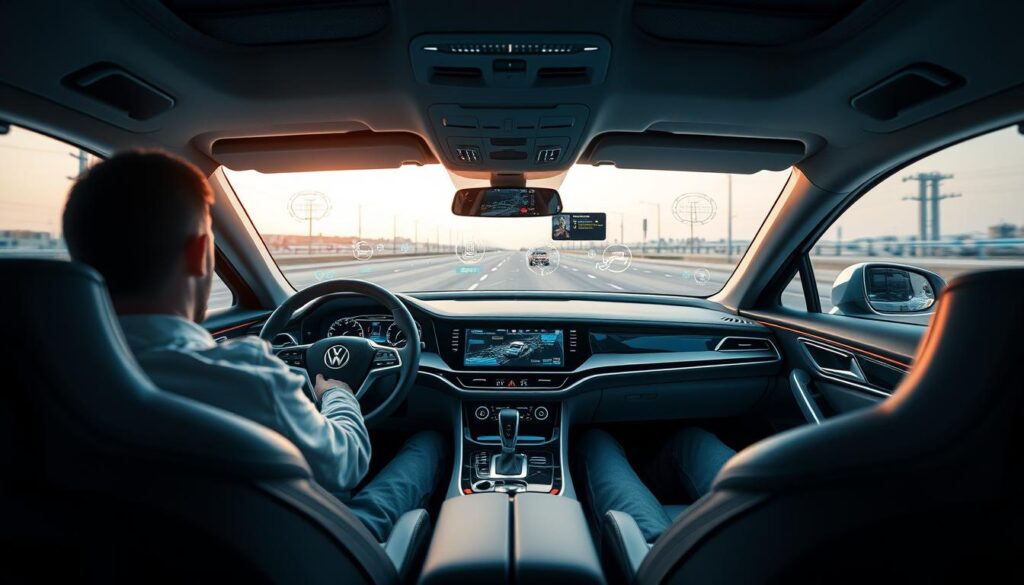
Benefits of ADAS in Everyday Driving
ADAS offers many benefits for daily driving, like lowering accident risks and improving road safety. It adds a layer of protection and support for drivers. This makes ADAS a vital part of car safety, leading the way in safety features.
Blind Spot Monitoring Systems
Exploring safety technologies in automobiles is key. Blind spot monitoring systems are vital. They help prevent accidents by alerting drivers to unseen areas around their vehicle.
Our reviews highlight how blind spot monitoring prevents accidents. It makes driving safer. The main benefits are:
- Enhanced visibility and awareness of the vehicle’s surroundings
- Reduced risk of accidents caused by blind spots
- Increased driver confidence and peace of mind
Understanding blind spot monitoring is important. It shows how it boosts safety and visibility. As safety technologies in automobiles evolve, blind spot monitoring will stay essential.
Lane Departure and Lane Keeping Assist
We’re dedicated to teaching you about car safety technology. This includes lane departure warning and lane keeping assist. These advanced safety systems help prevent vehicles from leaving their lanes. This is a big cause of accidents.
Lane departure warning uses cameras and sensors to alert the driver if the car drifts. Lane keeping assist then adjusts the steering to keep the car in its lane. This is great for long drives or busy traffic, as it cuts down on driver tiredness and accident risk.
Understanding Lane Departure Warning
Lane departure warning is a key feature. It warns the driver if the car starts to leave its lane. The warning can be a visual alert, an audible beep, or a vibration in the seat or wheel.
Benefits of Lane Keeping Assist
Lane keeping assist goes further by adjusting the steering to keep the car in its lane. It’s very helpful when the driver is distracted or tired. It stops accidents from happening because the car drifted out of its lane.
The main benefits of lane departure warning and lane keeping assist are:
- Less chance of accidents from drifting out of the lane
- Less driver tiredness on long trips or in heavy traffic
- Better safety on the road
By adding these advanced safety systems to our cars, we make the road safer. As car safety technology gets better, we’ll see more features that keep us safe and comfortable on the road.
Forward Collision Warning and Automatic Braking
Top-rated car safety features are key to avoiding accidents. Forward collision warning and automatic braking are among the best. They use sensors and cameras to watch the distance to things ahead. They warn the driver and might even brake automatically.
Knowing how these systems work helps us see their importance in keeping us safe. For example, making vehicle systems faster can lower accident risks. Forward collision warning systems are great at stopping frontal crashes, a common accident type.
How These Systems Operate
These safety features combine radar, cameras, and sensors to spot possible crashes. If a crash is near, they warn the driver to act fast. Sometimes, they even brake automatically to avoid or lessen the crash.
Real-Life Scenarios Where They Help
In real life, these systems really work. They can stop accidents when drivers are distracted or miss something ahead. By choosing cars with these safety features, we make our roads safer.
Tires and Their Role in Safety
When we talk about making cars safer, we often think of fancy tech like lane departure warnings. But tires are just as important. The right tires can make a big difference in how well a car handles and stops.
We think it’s key to talk about how good tires are for safety. Tire quality affects how well a car sticks to the road. This is vital for staying safe. Also, the type of tire can change how a car performs in different weather and road conditions.
There are mainly two kinds of tires: all-season and performance. All-season tires work well in many conditions, like dry and wet roads. Performance tires are made for speed and handling, perfect for those who love to drive fast.
- All-season tires: provide a balance of performance in various driving conditions
- Performance tires: optimized for speed and handling
In short, tires are a big deal for car safety. Knowing about tire quality and type helps drivers choose the right ones. This makes driving safer, thanks to the latest car safety tech.
| Tire Type | Characteristics | Suitable For |
|---|---|---|
| All-season tires | Balance of performance in various driving conditions | Everyday driving, various road conditions |
| Performance tires | Optimized for speed and handling | Aggressive driving, dry roads |
The Future of Car Safety Features
The future of car safety is looking bright. New technologies like advanced sensors and artificial intelligence (AI) will change how cars keep us safe. With car safety technology, cars will get smarter and safer. They will be able to spot and avoid dangers before they happen.
AI will make cars even better at preventing accidents. They will learn from their surroundings and make smart choices. This means features like automatic braking and lane-keeping will get even better, keeping us all safer on the road.
We’re excited for what the future holds in car safety. With ongoing innovation, we’ll see even more ways to stay safe while driving. By keeping up with these advancements, we’re looking forward to a safer, more connected driving experience for years to come.
